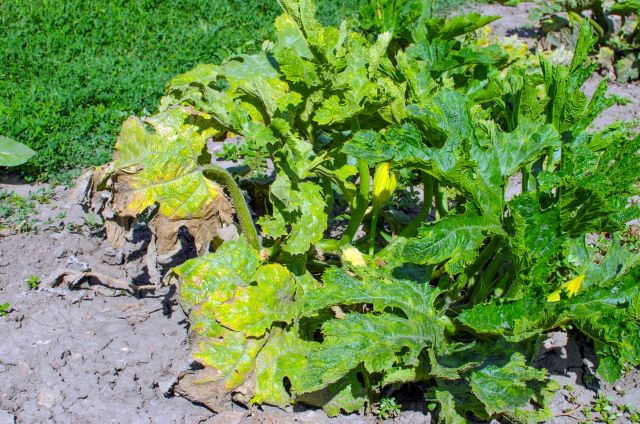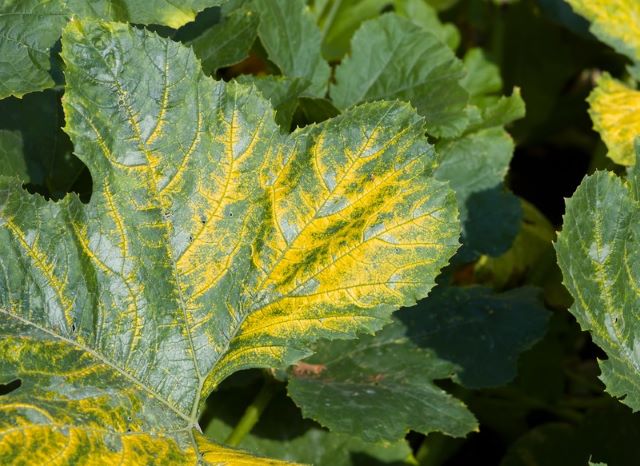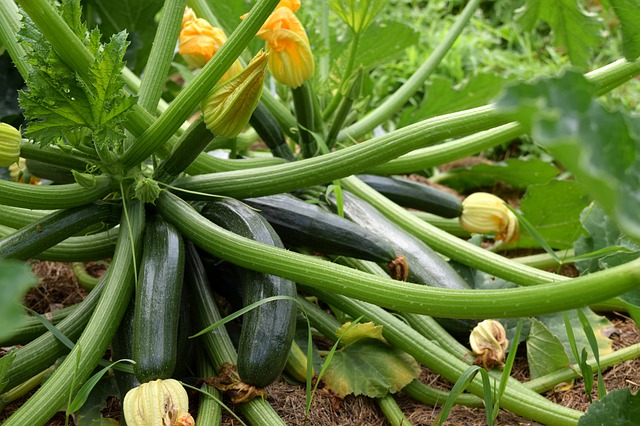When your zucchini leaves start to turn yellow, it can be confusing and frustrating. You want your zucchini plants to be as healthy as possible. So what’s gone wrong?

Well, zucchini, like other plants, contains chlorophyll, which allows it to perform photosynthesis and makes the leaves green. If something causes the zucchini plant to become unhealthy, it might produce less chlorophyll, and therefore the leaves will turn yellow.
What causes zucchini leaves to turn yellow? In this post, I’ll explore all of the common reasons and what you can do about them.
The most common reasons for zucchini leaves turning yellow are nutrient deficiencies, the wrong soil pH, watering problems, and not getting enough sunlight. Damaged roots, transplant shock, diseases, and pests can also be culprits.
Table of Contents
- Nutrient Deficiencies in Zucchini Plants Cause Yellow Leaves
- The Right Soil pH for Zucchini Plants
- Watering Problems for Zucchini Plants Cause Yellow Leaves
- Not Enough Sunlight for Zucchini Plants Causes Yellow Leaves
- Zucchini Plant Root Damage Cause Yellow Leaves
- Zucchini Plant Diseases Cause Yellow Leaves
- Pests on Zucchini Plants Cause Yellow Leaves
- Final Thoughts
Nutrient Deficiencies in Zucchini Plants Cause Yellow Leaves
Zucchini plants need nutrition to grow well. When there is a lack of necessary nutrients, the zucchini plant might start to suffer and develop yellow leaves. And most commonly, those nutrients are iron and nitrogen.
Yellowing leaves is one of the first signs of an iron deficiency in zucchini plants. However, this doesn’t necessarily mean that there’s not enough iron in your soil. Sometimes, the problem is that there’s actually too much of another nutrient.
If there’s too much of something else in your soil, especially phosphorus, it can prevent zucchini plants from absorbing the iron it needs. When fertilizing your zucchinis, try to choose a fertilizer that doesn’t have a lot of phosphorus in it.
The only way to know if you have an iron deficiency or a phosphorus overdose is to do a soil test! Luckily, at-home test kits like this one can easily tell you what you need to know, plus the pH of your soil.
Zucchini can also suffer from a lack of nitrogen. If your soil test reveals this, it’s easy to correct — just add some compost!
When trying to correct a nutrient deficiency, avoid using cow manure, because this contains a lot of phosphorus. Compost can help with nitrogen problems and rebalancing the soil. If you do have an iron deficiency, you can add chelated iron to the soil.
The Right Soil pH for Zucchini Plants
When you test your soil for nutrient levels, you should also test the pH levels. The ideal pH for zucchinis is between 6.5 and 7. If it starts to get higher than this, the soil becomes alkaline, and your leaves might yellow.
Compost can also help correct soil pH, on top of being full of useful nutrients. So don’t shy away from using it when you need to.
Watering Problems for Zucchini Plants Cause Yellow Leaves
Another common reason for zucchini leaves to turn yellow is problems with watering. This could be either too much or too little.
On average, zucchini plants need about one inch of water every week. If the top one to two inches of soil is dry, it’s time to water your plants.
Overwatered zucchini plants will struggle to absorb nutrients from the soil, because the excess water will compact the soil around their roots. This can also lead to root rot, which can be deadly. To help prevent overwatering, make sure your zucchinis are planted in well-draining soil that isn’t too full of clay or other heavy materials.
On the flip side, zucchinis that don’t get enough water won’t have the necessary energy to keep growing, and will also struggle to absorb nutrients. If zucchini plants are underwatered, they will start to droop and then wilt. If you notice them drooping, simply give them a good watering and they’ll start to bounce back!
While one inch a week is a good estimate, the amount of water your zucchini plants will need depends on location, weather, temperature, time of year, and age. So when in doubt, feel the top couple inches of soil, and if it’s dry, give the zucchini plant some water.
Not Enough Sunlight for Zucchini Plants Causes Yellow Leaves
Zucchini plants need full sun, meaning they need six to eight hours of direct light every day. Without this, they won’t be able to grow as well, and the zucchini leaves will start to yellow.
If your zucchinis aren’t in a sunny location, there’s only one thing to do: move them. Be careful doing this, though, so you don’t upset the roots too much.
Choose a location that gets lots of direct light, and isn’t being blocked by a tree or the corner of a building. Also, make sure there aren’t other plants nearby whose leaves could overshadow them.
If you’re growing zucchini indoors, you can simply add grow lights to give your plants the boost they need. Just make sure they get at least six to eight hours of direct light, and you’ll be good to go.
Zucchini Plant Root Damage Cause Yellow Leaves
These squashes have a very shallow root system, and it can be easy to accidentally cause damage or stress to the zucchini plant roots.
Transplanting your zucchini plants can stress the roots, known as transplant shock. To lessen the chance of this happening, you can plant your zucchini in biodegradable containers, so if you do have to transplant them, you don’t have to disturb the roots as much.
Additionally, digging near the base of your zucchini plants can accidentally harm the roots. Be careful when working near your zucchini, so you lessen the chance of causing them more stress.
Unfortunately, once zucchini plants have damaged or stressed roots, there isn’t much you can do. If you keep the plant healthy and in good conditions, they may be able to bounce back. So just treat them the best you can and hope that they can pull themselves through
Zucchini Plant Diseases Cause Yellow Leaves

As any gardener knows, diseases can also cause zucchini leaves to turn yellow. Diseases and pests are a lot harder to fight than the other things I’ve mentioned, but they can still be managed or prevented.
When it comes to yellowing leaves, there are three common zucchini plant diseases that might be the culprit.
Fusarium wilt is a fungal disease that causes yellowing of zucchini plant leaves. It’s commonly spread by the cucumber beetle, but can also spread through air or water. Like most fungal diseases, it thrives on moisture. Avoid overwatering your zucchini plants to help prevent it from taking hold.
In the long run, crop rotation also helps with fusarium wilt. If you change locations every year, the fungus can’t take hold again in the same area. You can also try attracting helpful ladybugs or parasitic wasps to take care of the beetles that spread it.
Cucumber mosaic virus and yellow mosaic can be spread by aphids, and causes zucchini plants to yellow and die. Again, beneficial insects can help with the aphids, and crop rotation can be useful. You should also get rid of the aphids, which I’ll talk about soon.
Lastly, downy mildew can harm your zucchini plants. It prefers damp, cold, crowded environments. On top of yellowing, you will also find a fuzzy white layer on the underside of leaves that is telling of downy mildew.
To prevent this from taking hold, make sure your zucchinis are in a warm environment and not overwatered. Additionally, make sure there’s space between the zucchini plants for air to flow. This will allow more circulation, which makes it harder for downy mildew to thrive. Often, downy mildew isn’t fatal, but for young plants or severe cases it can be.
With any disease, sometimes your best option is getting rid of the plant. You should remove infected leaves as soon as you spot them, and don’t put them in your compost pile. If it takes over a whole plant, and the strategies above don’t work, it’s best to get rid of that plant, to prevent it from spreading to the rest of your garden.
Pests on Zucchini Plants Cause Yellow Leaves
Just like diseases, pests can be difficult to spot and deal with. Luckily, there are ways of getting rid of the most common zucchini plant pests.
First off, aphids. I really don’t like these pests. They can spread diseases, like I mentioned above. They also feed on your leaves, and leave a sticky residue behind.
Attracting helpful insects, like ladybugs and parasitic wasps, can help kill off aphids. You can also spray your plants with a blast of water from the garden hose or a mixture of horticultural neem oil and water, which will get rid of them and prevent their eggs from hatching.
Spider mites are similarly annoying. These little critters leave faint webbing across plants, which is how you can identify their presence. They also feed on leaves, and can quickly multiply and kill your zucchini plants. Once again, helpful insects or a spray mix of neem oil and water will help you.
Lastly, squash vine borers. As their name suggests, these pests bore a hole into the insides of your zucchini plants and feed off of them. They are larger than the other pests I mentioned, and easier to spot both by seeing them and the holes they make.
Spreading diatomaceous earth around the base of your zucchini plant helps fend off borers. Spraying the plants down with soapy water might also kill them. If you’re willing to, you can put on gloves and pluck these pests off the plants yourself, tossing them in a bucket of soapy water to kill them.
Related: 11 Zucchini Pests (And How to Get Rid of Them!)
Final Thoughts
Identifying why your zucchini plant has developed yellow leaves and taking action to remedy the problem should result in an abundant harvest of garden-fresh zucchini.

Further reading:
- 12 Zucchini Plant Diseases And How To Fix Them
- Why Is My Zucchini Plant Dying? Causes And Solutions
- Growing Zucchini: Planting, Caring, And Harvesting Zucchini
- Why Is My Zucchini Flowering But Not Producing?
- Why Is My Zucchini Bitter? (And how to fix it!)
- Why Are My Zucchinis So Small? With Solutions!
- Tomato Seedling Leaves Turning Yellow: Causes and Solutions
- Why Are My Sweet Potato Leaves Turning Yellow?
- Beet Leaves Turning Yellow? Causes and Solutions
- Why Is My Corn So Small? Causes and Solutions
